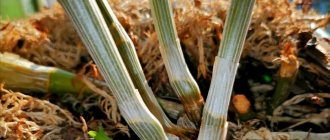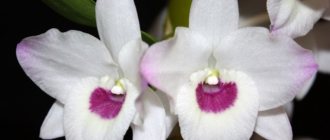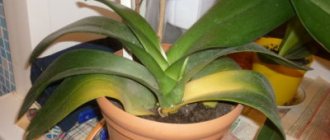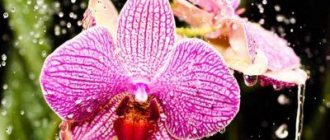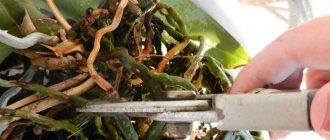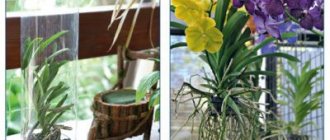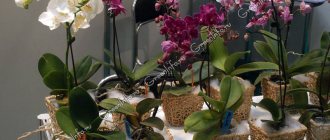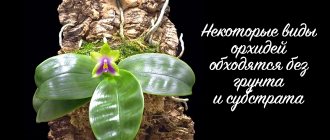Dendrobium Nobile is one of the most beautiful types of orchids, which is the most commonly grown hybrid at home. The natural habitat is the tropical mountain forests of South and Southeast Asia. The plant is valued for its presentable appearance, abundant flowering, and exquisite slightly sweet floral aroma.
Types and varieties of orchids
Among the varieties grown today, the most common subspecies are:
| Subspecies | Peculiarities |
| Dendrobium aphyllum | It is distinguished by a reddish tint of foliage and pseudobulbs. Loves bright sunlight and tolerates exposure to direct sunlight. |
| Dendrobium bellatulum | During the flowering period, the miniature epiphyte is covered with waxy white flowers with a red-orange or yellow throat. Has a light pleasant floral aroma. |
| Dendrobium christyanum | The miniature epiphyte Christie has white or cream-colored flowers with characteristic veins. The difference is the violin-shaped throat with a red-orange or yellow central part. |
| Dendrobium densiflorum | An exotic from the Eastern Himalayas during the flowering period is covered with clusters of fragrant flowers with bright yellow petals and a yellow-orange fringed throat. |
| Stardust | A specimen with a thin elongated pseudobulb up to 20 mm wide and red-orange or pale yellow flowers about 6 cm in diameter. |
| Phalaenopsis | The variety blooms 2-3 times a year, for 2-3 months. The color of the peduncles varies from white to dark purple. |
| Parisha | The miniature epiphyte has aerial roots and small flowers up to 2 cm in diameter. The color is milky white, with a purple throat. It blooms profusely and exudes a pleasant aroma. |
| Irene smile | The buds are scattered along the entire length of the trunk at a distance of 2-5 cm. The flowers are white-lilac in color with a yellow core. The epiphyte blooms twice a year, flowering duration is 4 weeks. |
| Unit | The epiphyte has a pseudobulb with a yellow color and multiple furrows. Clusters of inflorescences consist of 12-15 flowers with an amazing aroma, reminiscent of the sweetness of honey or molasses. |
| Akatsuki | Subspecies with dark green lanceolate leaves. The flowers are medium-sized, softly lilac in color, with a yellow core and a white (less often blue) edge. The diameter of the largest bud is 40 mm. It exudes a light floral aroma, more intense during the day and barely noticeable in the evening. |
| Apollo | A hybrid with a fleshy stem and dense leaves of a rich green color. It blooms 12 weeks a year, the flowers are white with a yellow throat, several are located on one peduncle. |
| King | In nature it is found on steep cliffs. It is distinguished by the presence of white scales on the stem, long lanceolate leaves, and medium-sized white flowers with a pink or lilac tint. |
Growing
Growing specimens of the Nobile variety is a difficult and responsible process, since the conditions in the house are very different from natural ones. And, as you know, the natural habitat of epiphytes is the tropical zone, the climate of which is extremely difficult to replicate in an apartment or house, but still possible.
Pot for Dendrobium
For exotics, the condition of the root system is extremely important. Therefore, special attention must be paid to the container that will serve as its “home.”
Since Nobile roots do not participate in photosynthesis, they do not require good lighting. Therefore, the main criterion when choosing a flowerpot should not be transparency, but the porous structure and breathability. A ceramic pot has these properties. A clay product “breathes” well and maintains optimal temperature and humidity levels. The bottom must have a drainage outlet. It is optimal if small holes are also located on the walls.
The size of the new container is equally important. Dendrobium Noble prefers cramped pots, so the distance between the roots and the walls of the flowerpot should not exceed 1.5-2 cm. You should not buy a ceramic pot with a “spare” - in a spacious container there is a risk of soil acidification.
Before planting, the pot must be properly prepared:
- treat with any disinfectant;
- bake in the oven at 200°C for at least 2 hours;
- cool and then place in clean water for a day so that the pot is saturated with moisture.
Soil for Dendrobium
Soil mixtures intended for growing ordinary indoor crops are very different from the substrate for orchids. Since the roots absorb a lot of air, you should choose light, loose soil. You can purchase a special soil mixture at a flower shop or prepare it yourself.
Optimal substrate composition:
- Pine tree bark. It is pre-boiled and dried to remove fungus and other infections.
- Sphagnum moss. It helps retain moisture within the soil.
- Charcoal. Divided into small pieces, it protects the substrate from souring during frequent watering.
- Crushed fern root. Suitable for loosening soil. As an alternative, coconut fiber, crushed wine cork, and pieces of polystyrene foam are used.
Expanded clay, river pebbles, crushed stone, and large fragments of tree bark are used to create a drainage base. To enrich the soil, it is useful to add a small amount of peat.
Humidity
Being an exotic, the representative of the Nobile variety grows better and fully develops at normal and high ambient humidity. In the summer heat, as well as in winter during the heating season, the bush slows down and sometimes stops its growth. Therefore, it is important to maintain air humidity at 40-60%.
You can increase the moisture level in this way:
- spray the ground parts with a spray bottle;
- wipe the leaf plates with a damp cloth at least 3-4 times a day;
- place the pot with the plant on a tray with moistened moss, expanded clay, and pebbles;
- purchase an automatic humidifier.
Temperature
In order for Nobile to develop normally and bloom, it is necessary to maintain not only suitable humidity, but also air temperature. Optimal daily indicators:
- in summer – 22-28°C;
- in winter – 15-20°C;
- in autumn and spring – 16-22°C.
However, with comfortable air humidity, exotic feels great even at 30-32°C.
An important stage of the annual cycle is the formation of buds. At this stage, it is important to maintain the temperature: 24-25°C during the day, 18-20°C at night. To stimulate the abundant appearance of flowers, it is necessary to ensure a difference in daily values of 5-10°C. To lengthen the budding process, the temperature must be lowered to 18°C. For normal development and timely flowering of an exotic crop, it is necessary to maintain a suitable temperature at home.
Optimal daily indicators:
- in summer – 22-28°C;
- in winter – 15-20°C;
- in autumn and spring – 16-22°C.
However, with comfortable air humidity, exotic feels great even at 30-32°C.
An important stage of flowering is the formation of buds. During this period, the temperature should be maintained: 24-25°C during the day, 18-20°C at night. To stimulate the formation of flower stalks, it is necessary to ensure a daily temperature difference of 5-10°C.
Caring for a Dendrobium orchid at home
Dendrobium noble is very unpretentious in care and maintenance, but has a pronounced cyclical development. This means that it annually experiences 4 seasonal stages:
- active vegetation;
- budding period;
- bloom;
- rest phase.
If suitable conditions are created for each time period, this will ensure proper care.
How to water
Watering is an important part of comprehensive care for Dendrobium Nobile. An indicator of the presence or absence of moisture inside the substrate is the condition of the roots. The signal for watering is considered to be:
- change in root color from green to light gray;
- the substrate dries so much that the pot becomes light;
- decreased leaf elasticity.
The frequency and frequency of watering depends on the conditions of detention and the stage of development. The plant should be watered after the soil has completely dried. Boiled or filtered water slightly above room temperature is suitable for moistening the soil.
The regularity of watering also depends on the time of year:
- in summer - every 2-3 days;
- in autumn and winter - no more than 2-3 times a month.
After the flowering period ends with the onset of the resting phase, watering should be reduced to once every two weeks, while maintaining the frequency of spraying.
The epiphyte should be watered by immersing the flowerpot in a basin of warm water for 10-15 minutes. To remove excess moisture, you need to twist the pot, tilting it in different directions. During the procedure, you should avoid getting water inside the rosettes and bulbs to protect the bush from rotting.
Fertilizers
In addition to watering, it is important to feed Dendrobium in a timely manner, since its roots cannot receive the nutrients necessary for healthy growth from poor soil composition. Complex mineral fertilizers, which are used in the form of liquid solutions, are suitable for this purpose.
Depending on their composition, they are divided into two groups:
- Nitrogen-containing complexes. Used during active development to increase green mass.
- Potassium-phosphorus preparations. They are used at the stage of bud formation.
Liquid mineral compositions are applied every two waterings. If the immersion method is used, the dosage is reduced to half that recommended by the manufacturer. When foliar feeding for spraying leaves, the dose is reduced to 5 times. To prolong the budding period, fertilizing with mineral compounds should be limited as much as possible, and with the onset of the resting phase should be completely stopped.
Cutting
After Dendrobium Noble has bloomed, it is recommended to prune it. This is not done immediately, but after the old yellowed pseudobulbs have completely dried out. Until this moment, they are a source of food for young shoots. The cut areas should be slightly dried and then sprinkled with powdered charcoal.
Wintering
After the flowering phase, the bush goes into a dormant state. In order for him to have time to rest, it is necessary to change the tactics of care:
- Move the flowerpot to a cool place, maintaining the air temperature there: during the day - within 16-20°C, at night - 10-12°C.
- If the air temperature outside at night does not drop below +10°C, the plant can overwinter on a loggia or glazed balcony.
- Watering should also be gradually reduced, initially to 2 times a month, then to 1, and then stopped completely. The same applies to feeding.
If the pseudobulbs take on a wrinkled appearance, you need to spray the leaves and substrate with water from a spray bottle. In the last month of winter, you need to closely monitor the plant so as not to miss the moment when it begins to awaken.
How to care during and after flowering?
Dendrobium orchid care consists of three parts:
- Care before Dendrobium blooms.
- Rules of care during flowering.
- The dendrobium has bloomed. Care after flowering.
Each of them has its own rules of care, since each of the orchid periods carries with it some kind of sequence. And if they are not observed, the flower will either not bloom or die.
How often do buds appear?
An orchid can begin to bloom at any time, it all depends on the speed of its development life cycle. Basically, the flowering of the daytime orchid begins in the fall and lasts until spring. Inflorescences can be of various colors:
- white;
- pink;
- lilac;
- yellow;
- crimson.
Attention! Dendrobium can bloom from 2 weeks to 2 months. This period depends on proper care during flowering.
Rules of care during this time
When flowering Dendrobium indoors, it is necessary to observe the temperature regime. Otherwise, the orchid buds may develop into “babies”, as a result of which the plant will no longer bloom. Since the plant spends a huge amount of vitality for the development of young shoots.
In order for the flowering to be lush, during the dormant period of Dendrobium it is necessary to reduce its watering and move the plant to a cool and bright place. It is also important to provide access to fresh air, but avoid drafts.
What to do next?
After the Dendrobium has bloomed, it is necessary to gradually reduce watering until it stops completely. Then the stem of the peduncle needs to be cut off and the bush moved to a cool place.
In order for the plant to rest and gain strength for new flowering. In winter, daylight hours decrease and the bush may hibernate. In such cases, it is necessary to leave the plant alone, providing the necessary care.
Dendrobium bloom
In different regions and for each grower, the exotic Nobile crop begins to bloom at different times. This is due to the varietal characteristics of the hybrids, as well as their growing conditions.
Traditionally, representatives of the Nobile variety begin to bloom in early spring (from about the end of February to May). With proper care, exotic flowers continue to bloom for 3-4 months. And this happens every year. However, it happens that the bush misses the flowering season and produces buds only the next year, but lays more buds. With proper feeding you can achieve abundant flowering. To enjoy the delicate beauty and delicate aroma longer, the flowerpot with the epiphyte should be moved to a dry, cool place protected from sunlight.
In some exotic species, the period of budding and flowering ends with yellowing and falling of the once green foliage. This is how the plant prepares to move to a new stage - the dormant period. Reutilization of useful substances occurs: dying terrestrial parts become a source of nutrition for new growing pseudobulbs. For this reason, the peduncle with pseudobulb is not cut off, but is allowed to dry out on its own. If it continues to remain fresh, this means that the plant is preparing for the appearance of new babies. During this period, it is important to adjust the care of the epiphyte and ensure subsequent lush, long-lasting and abundant flowering.
Why might it not bloom?
The absence of one of the most important conditions in the life of a plant signals improper care for it. Speaking about specific reasons, it is worth considering several factors that affect the fact that Dendrobium does not produce new buds:
- Problems with the root system. They can occur due to disease, overdried or, conversely, chronically wet soil. Dead, rotted or mechanically damaged epiphyte roots no longer perform their main function, and the plant does not receive the necessary resources.
- Lack of lighting. Occurs due to improper placement of the flowerpot. It is important to remember that each variety, even those bred by breeders, prefers special conditions. This means that if most of the different orchids are on the same windowsill, not all of them are equally comfortable. You should study the flower's preferences regarding the length of daylight hours throughout the year and determine how much UV radiation it needs. Some epiphytes can exist quietly in partial shade, but will not bloom, while others are afraid of the sun and throw out buds when they are away from its rays.
- Not enough water. Again, it is worth paying attention to the needs of a particular Dendrobium species.
- Cold microclimate in which the flower is frozen.
- Frequently moving the pot from one place to another. This leads to severe stress and prolonged adaptation, during which the appearance of buds should not be expected. Moreover, even formed ovaries may fall off.
This is interesting: in Nobile, children, like the cobs, which will later turn into flowers, grow directly on the trunk, consisting of elongated bulbs, similar to barrels.
Why doesn't a variety like Berry Oda bloom?
This hybrid stops pleasing the owner with beautiful petals if the maintenance regime is violated. Improper care also leads to diseases or pest damage, which is also not a positive factor.
The most common reasons leading to poor formation of arrows and buds:
- Instead of flower stalks, new children are formed. This means that the plant receives insufficient light and the air temperature is too high. A similar situation often arises in winter, when daylight hours are shortened and the pot is placed on the windowsill close to a hot radiator.
- Flowers have not appeared for more than a year and a half. With a constant lack of light or without observing the correct regime, taking into account the dormant period, the plant stops throwing out buds. Daily temperature changes and proper rest are the main factors for the successful formation of the necessary buds.
- Flowers that have barely bloomed immediately dry up. This is the first sign of pest infestation or heat in dry air.
Important: Please note that each owner’s Dendrobium grows under different conditions and is cared for differently. This means that the reasons for the lack of flowers should not be the same either.
Transfer
The main difference between Noble orchids and ordinary indoor plants is their painful sensitivity to replanting. The epiphyte experiences stress and takes a long time to get used to its new “place of residence”, so it should be disturbed no more than once every 3 years. After purchasing, you should analyze the well-being of the orchid. If it is assessed as satisfactory, it is advisable to postpone the transplantation process until the next season.
However, there are situations when it is better not to hesitate:
- Unsuitable condition of the soil mixture. Over time, the substrate acquires excessive density and, when dried, breaks down into fine-grained fractions. It does not allow air to pass through well, does not accumulate nutrients, and becomes salty with compounds contained in the water.
- The capacity has visually become small. Due to excessive growth, the roots become cramped in the old flowerpot. Due to lack of lighting and aeration, they lose the ability to grow and develop normally.
- Damage by disease or pests. This is evidenced by the appearance of brown spots on the roots, yellow or black spots on the leaves. The latter become sluggish and lose elasticity.
It is recommended to carry out a planned transplant of the Nobile orchid in the spring, after the end of the flowering phase. For this purpose, the transshipment method is used.
Instructions:
- Water the orchid to make it easier to remove from the old pot;
- prepare a new flowerpot as described in the previous instructions;
- lay drainage at the bottom, and on top of it a 2-3 cm layer of soil;
- carefully, so as not to damage the earthen lump, remove the bush from the old pot;
- place in an empty flowerpot;
- holding the stems at the base with your left hand, quickly fill the voids with fresh substrate with your right hand;
- install a support to which to tie the plant;
- transfer to a cool (+20°C) shaded place.
If some of the roots are affected by rot, you will need to remove the affected parts with a sterile knife and treat the sections with charcoal. Place the orchid in a dry basin and leave for some time. When the roots dry out and the cuts become tight, transfer the orchid to a new pot, as described above.
The first full watering after transplantation is recommended after 7-10 days. By this time, the plant will have time to adapt to its new place of residence. Before this, only light irrigation on the leaves is allowed.
Reproduction of Dendrobium Nobile
A representative of the Nobile variety is a crop that can be propagated easily and in different ways. The most commonly used are 4 methods: by children, cuttings, bushing, using young bulbs.
Children
The simplest and most reliable method of propagation at home, suitable for beginning growers. Children are called lateral processes that appear on the pseudobulb instead of a flower.
To get a new bush, you need:
- Using a sterile knife with a sharp blade, cut off the baby so that it contains a fragment of the mother's pseudobulb.
- Place in the open air for 2-3 hours so that the cuts heal faster.
- Powder the cut areas with charcoal powder.
- Place drainage at the bottom of the pot and pour a moistened soil mixture of bark and sphagnum moss.
- Plant the baby in a fresh substrate, slightly deepening it.
Create greenhouse conditions to speed up the rooting process. To do this, cover the container with a glass jar or plastic bottle, and regularly irrigate the soil with warm water from a spray bottle.
Cuttings
A longer and not always successful method of breeding, however, with some diligence, it is possible to obtain several strong young specimens from one cutting. An old pseudobulb without foliage is suitable for preparing “working” material.
Algorithm of actions:
- Divide a pseudobulb about 10 cm long cut from a bush into cuttings so that each of them has 2-3 dormant buds.
- Dry the sections and dust them with charcoal powder.
- Prepare containers in which to place a thick layer of moistened sphagnum moss in advance.
- Place the cuttings in containers and cover with a lid (film, glass).
- Place in a bright and warm place for several weeks.
- The improvised greenhouse needs to be regularly ventilated and the moss moistened.
When the roots reach 5 cm in length, the seedlings are ready for planting.
With the help of a young bulb
For propagation using this method, a non-flowering bulb of a young plant is suitable. In order for a new orchid bush to grow from it, you will need:
- Prepare a transparent bag or an elongated container and place sphagnum moss, which must first be moistened.
- Using a sharp knife, carefully cut off the pseudobulb, treat with charcoal powder and air dry.
- Place the bulb in a bag, which is transferred to a warm, bright place.
- Leave for several weeks until young roots appear. The container must be periodically ventilated, and the substrate must be moistened.
- Plant the finished seedlings in nutritious soil.
Dividing the bush
This method requires utmost attention and accuracy when performing work. An adult healthy bush that has a sufficient number of pseudobulbs is suitable for propagation.
Procedure:
- Using a sharp knife, divide the bush into two equal parts so that each of them has old, mature and young shoots.
- Treat fresh cuts with crushed coal.
- Leave the resulting blanks for 24 hours to dry and heal the wounds.
- Plant new bushes in pots with a pre-prepared substrate and drainage layer.
Which pot to choose
It is worth choosing a container for planting dendrobium with plenty of drainage holes. The flower should sit firmly in the substrate, but the roots should not be crowded. The roots of these noble orchids are well developed, prone to branching, and require drainage and aeration.
Typically, plastic pots are used to grow dendrobiums. Clay pots will also work as long as they are not heavily glazed. The porous structure of the clay will allow the soil to dry out faster and reduce the risk of root rot.
At the first signs of salt accumulation on the substrate, it should be renewed.
Problems with growing Dendrobium
Despite the fact that the epiphyte variety Nobile is undemanding to its maintenance conditions, many novice gardeners make mistakes when growing it. This leads to the development of disease and even the death of the culture.
- Burns appear on the leaf blades. This occurs if, after spraying, the crop is exposed to direct sunlight.
- Dark, wet spots form on the foliage. The bush is in an excessively cool room, and after irrigation it does not have time to dry out.
- The orchid does not bloom. The plant experiences a lack of heat and light.
- Flowering does not occur, and new bulbs are formed from the buds. At the stage of flower stalk formation, nitrogen-containing fertilizers are used for feeding.
What to do if the problem persists?
Here you will have to use extreme measures in the form of plant transplantation. After carrying out the transplantation procedure with a complete replacement of the soil, you need to hold off on watering and pay more attention to spraying the plant. Fertilizer cannot be used during this period. If, however, the yellowing of leaves from the stem does not stop after the above procedures, then the affected stems should be removed. In order to preserve the plant, normalize its care .
Follow the rules for caring for dendrobium and in gratitude the plant will delight you with beautiful flowering and health.
If you find an error, please select a piece of text and press Ctrl+Enter.
“>
- Author: Maria Sukhorukikh
Rate this article:
- 5
- 4
- 3
- 2
- 1
(0 votes, average: 0 out of 5)
Share with your friends!
Diseases and pests
Representatives of the Nobile variety, like ordinary indoor crops, are susceptible to diseases and pest attacks. However, with proper care and the creation of the necessary conditions of detention, such problems can be avoided. If the crop nevertheless loses its healthy appearance and begins to wither, it is necessary to promptly identify the cause of the deterioration and eliminate it. Otherwise, this may lead to the death of the culture.
| External manifestations | Cause | Remedy |
| Leaves wither and become covered with dark, dry spots | Fungal infection | Removing “sick” parts; Protection of cuts with carbon powder; Treating the bush with a solution of an antifungal drug, for example, Skor, HOM, Horus; Refrain from moistening the soil for 5-6 days; Subsequent watering should be carried out with water with the addition of a solution of potassium permanganate. |
| The substrate becomes moldy. Acquires a persistent putrid odor; dark, weeping spots appear on the roots and then on the leaves. | Root rot infection | Remove the bush from the pot, free it from the earthen clod; Remove the diseased parts, place the roots in a solution of potassium permanganate; Wash the pot thoroughly, disinfect it, fill it with drainage and fresh substrate, with the addition of the drug Trichodermin; Plant a bush, which is watered for several months with water with the addition of 0.5% fungicide. Previkur, Baikal-EM, Bayleton are suitable. |
| Leaves and buds become covered with a white coating, after which they dry out and fall off. | Powdery mildew | Remove plaque with a soap solution; For a month, regularly spray the above-ground parts of the plant with any fungicide (Topsin-M, Spor) or a solution of colloidal sulfur. |
| On young foliage, shoots, buds, the accumulation of small green or brown insects increases | Aphid damage | Remove bugs with plain water; Prepare an onion, garlic, tobacco or herbal solution and spray the plant with it several times a day; In case of significant damage, use insecticides - Biotlin, Fury, Inta-Vir. |
| The leaf blades are covered with light lines, turn yellow from the inside, the flower stalks curl without opening | Thrips | Spray with a strong soap solution; Treat the ground parts with an insecticide (Fury, Tanrek, Mospilan). Repeat the procedure at least 1-2 times with an interval of 5-7 days. |
What to do if there is no improvement?
If all of the above reasons are eliminated, but the leaves still turn yellow, then the flower’s roots may have begun to rot. In this case, you need to replant the plant, first wash the root system in a weak solution of potassium permanganate, dry it and trim off all damaged areas. Then sprinkle the sections with ash or activated carbon and plant them in a new, disinfected substrate.
There can be many reasons for the yellowing of an orchid's leaves, and you need to try all the ways and methods to save this beautiful exotic plant.
If you find an error, please select a piece of text and press Ctrl+Enter.
Problems associated with violating the conditions of keeping dendrobium:
1) There is no flowering (18 months), new pseudobulbs are formed long and thin.
The reason is insufficient lighting when maintaining the plant.
2) Root rotting (the roots have turned brown).
The reason (and, or) is watering the orchid during the dormant period; violation of the frequency of watering during the period of active growth; the soil substrate has decomposed; use of unsterilized soil mixture when planting (transplanting); an initially infected (sick) plant was purchased.
Photo of orchid Dendrobium Nobile
The blooming orchid in the photo resembles a lush living bouquet of many beautiful buds.

